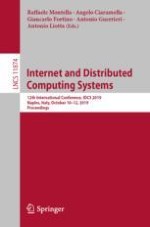2019 | Buch
Internet and Distributed Computing Systems
12th International Conference, IDCS 2019, Naples, Italy, October 10–12, 2019, Proceedings
herausgegeben von: Dr. Raffaele Montella, Angelo Ciaramella, Giancarlo Fortino, Dr. Antonio Guerrieri, Antonio Liotta
Verlag: Springer International Publishing
Buchreihe : Lecture Notes in Computer Science
